The cemetery of the Shu State is a cemetery cemetery from the Western Zhou Dynasty to the Spring and Autumn Period. It has undergone two large-scale excavations and has more than 30,000 pieces of cultural relics unearthed. In particular, nearly 10,000 pieces of jade unearthed, complete in variety, excellent in jade, exquisite in style, beautiful in ornamentation and exquisite in craftsmanship, the high value of which is rare in the archaeology of the Zhou Dynasty. It is an art treasure in the pre-Qin period of China. The most amazing thing is that the jade artifacts unearthed from the Tomb of the Suizhong (M2009), with a number of more than 800 pieces, is another amazing discovery after the jade wares unearthed from the Yinxu Women’s Tomb. It became a hot spot at home and abroad. Many experts and scholars are lamented. Among these unearthed jade articles, there are many phoenix-shaped jade wares and phoenix-shaped jade wares. They are not only excellent in texture, beautiful in shape, but also rich in ornamentation and fine workmanship. They are an indispensable part of the jade carvings.
First, the phoenix bird pattern (shaped) jade introduction
The phoenix-shaped jade is mainly concentrated in the jade class.

Sanguan Yufeng (see Figure 1), 12.9 cm high, 3.8 cm wide and 0.5 cm thick. Sapphire. Ice blue, partially smashed into a yellowish brown. The jade is fine and slightly transparent. The phoenix bird is standing, with nails, round eyes and three crowns. Each end of the crown is divided into three forks. The head is high and has a molar, the wings are upturned and the tail is drooping. The crown and neck are decorated with a circle pattern, and the body is decorated with a moiré pattern. A piercing of the mouth. As a whole, a gentleman in a tuxedo stands tall, powerful and energetic.
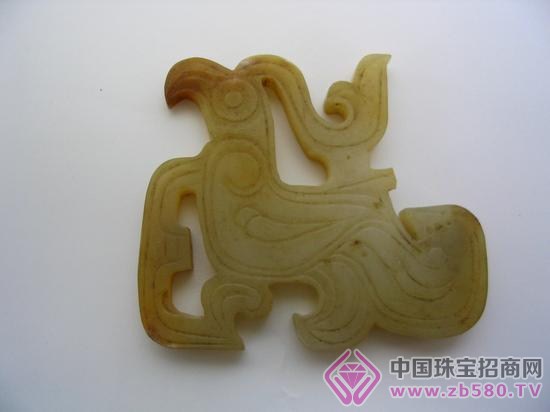
Yufeng (see Figure 2) is 3.5 cm high, 4.1 cm wide and 0.4 cm thick. Sapphire. It is blue-white, and the body part is covered with yellow-brown spots. Warm and smooth, translucent. The bird stands tall, with a pointed hook, a round eye, a long crown and a roll, a tail full of forks, a part curled back and up, and a small part bent downwards, which seems to be used as a "foot". The body is formed in two hollows, and the body is decorated with a cloud pattern.
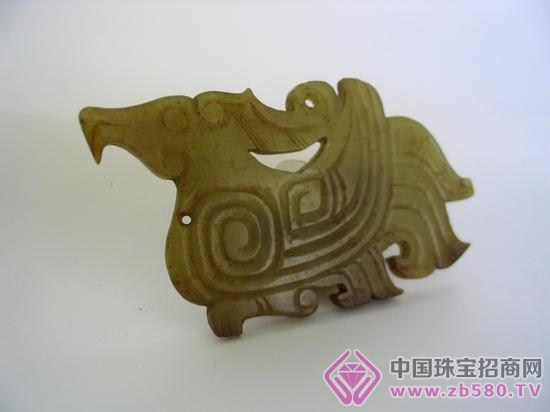
Yufeng (see Figure 3, Figure 4), a pair. Sapphire. Ice blue, partially affected by yellowish brown spots. The jade is delicate, moist and slightly transparent. The bird is prone to prone, nails, round eyes, neck-necked chest, long crown and then rolled up, claws attached to the ground, fishtail tail drooping. The body is decorated with a cloud pattern. There is a chest and a crown.
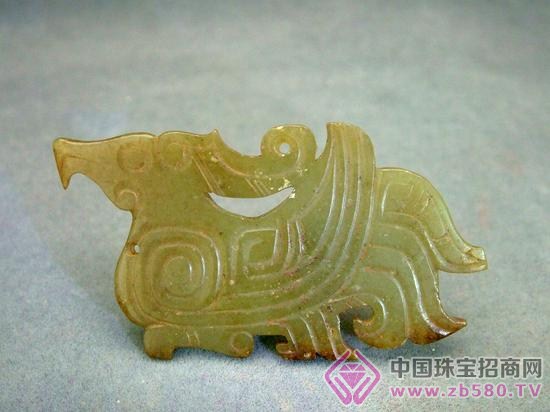
Yufeng (see Figure 5), white jade. It is blue-white and has yellow and white spots on the surface. The jade is delicate, warm and transparent. The bird is in a prone position, with the head raised, pointed, rounded, long crown rolled, long tail rolled up, claws attached to the ground, a small ring button under the tail, and a small round pierced in the chest. Wings, tails, and claws are engraved with lines.
The phoenix jade jade is mainly a decorative piece.
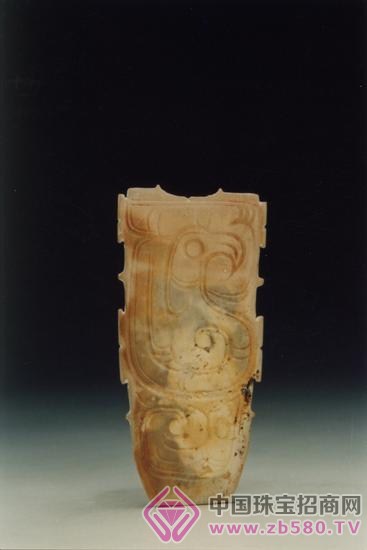
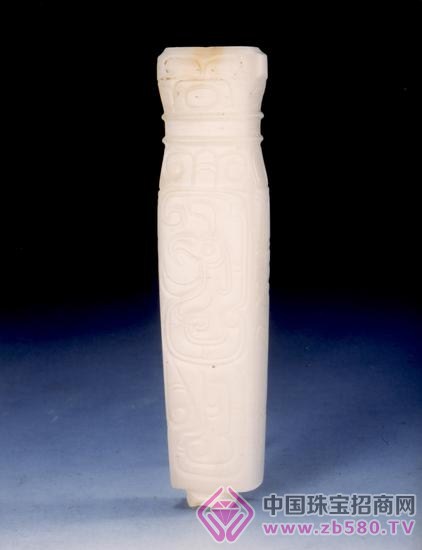
Phoenix bird jade handle (see Figure 6, Figure 7), two pieces. The former is 6.7 high, 1.7-3.2 wide, and 0.3 cm thick. Sapphire. The color is yellow and yellow, and it is heavier. The jade is delicate and slightly transparent. It is roughly like an isosceles trapezoid, a flat strip, a slightly wider top, a slightly sloping bottom, and a ridge on the top and sides. Each side of the back is decorated with a set of phoenix birds. The phoenix bird stands tall, with a rounded crown, curved hooks, high-footed claws, and the tail feathers roll up over the top of the head and then hang down on the chest. There is a perforation in the middle of the trapezoid. The latter is 9.1 high, 2.3 wide and 1.0 cm thick. Green white jade. It is blue and white, and the jade is good and transparent. Flat top, curved under the top, with a flaw at the end. The front and back sides are decorated with side phoenix birds, and the sides are decorated with creases. The phoenix bird has a convex chest, a long curved hook, a round eye, a high crown leaning forward, and the tail feathers are lifted upward from the back, and the top of the head is lowered from the front and the end is rolled up again. Both ends are drilled through the hole.
The phoenix bird pattern on the two utensils, the back of the neck, the tail feathers, the claws, etc. all adopt the deformed cirrus pattern commonly used in the Western Zhou Dynasty. The long curved lines are interspersed in the up, down, left and right, and the sleek and smooth, just right, all with a hook The technique is smashed out, making the image of the phoenix bird pattern more vivid and dazzling. This kind of phoenix bird pattern is proud of the world, but I am the only one who respects the grandeur and strong posture. It has become the perfect artistic portrayal of Zhou people's replacement of the "big slogan" with "Xiaobang Zhou" and winning the spiritual power of the world.

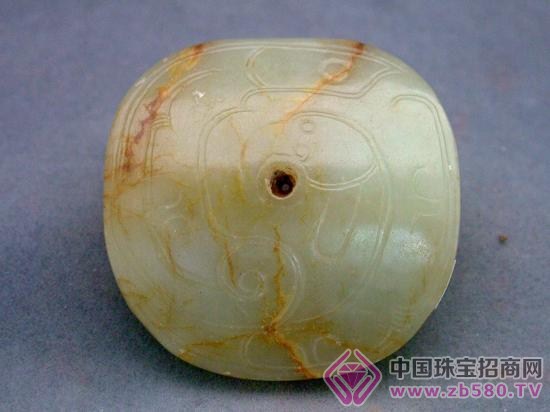
Phoenix bird-shaped round jade ornaments (see Figure 8, Figure 9), a pair. The former is cm in diameter. Sapphire. Ice blue, partially brownish brown. The jade is delicate and transparent. Round, with a small round in the middle. The latter has a long diameter and a short diameter of centimeters. Green white jade. It is blue-white and has yellow-brown markings on the surface. The jade is delicate and transparent. Nearly round, with a small round in the middle, the front side is bulged, and the back is correspondingly concave. The front side is decorated with a side phoenix bird pattern, round eyes, pointed mouth, thicken, and the body is curved with the shape of the body.
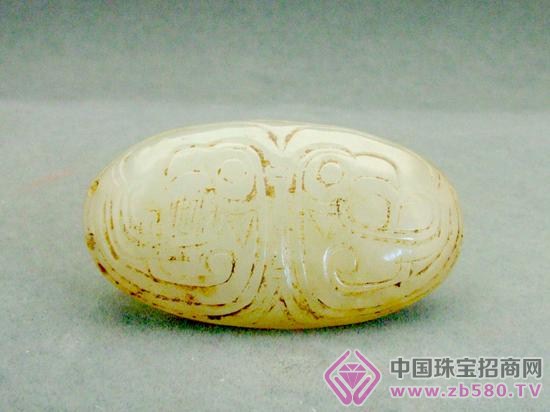
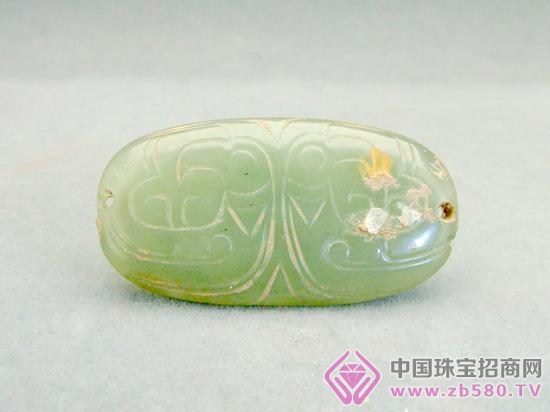
Double phoenix jade ornaments (see Figure 10, Figure 11), a pair. The shape, texture, size and gloss are the same, but the colors are different. The former is Hetian Baiyu and the latter is Hetian Qingyu. They are all long oval, with a frontal pattern, centered on the elliptical short diameter, and the same pattern of wind birds on both sides, the phoenix bird's tip, the hook, the round eye. Back light.
Second, the issue of phoenix bird pattern
The image of the phoenix bird appeared in the prehistoric Yangshao culture period. For example, the dragon and phoenix neck pots unearthed from the first ridge in the northwest of Shaanxi, and the double phoenix butterfly shaped on the ivory unearthed from Hemudu, Yuyao, Zhejiang. The prototype. Merchants believe in "the gods of the gods, but to live down to business", so a variety of bird patterns often appear on the merchant's bronze. In the Yinxu Women's Tomb, a jade phoenix was unearthed. It is very beautiful. It can be said that it was the earliest phoenix bird pattern appeared on the jade. It is usually considered to be a late Shang Dynasty work, but some experts believe that this jade phoenix is ​​not Yin Shang. The works belong to the Shijiahe culture of the Neolithic Age. During the Western Zhou Dynasty, because Zhou Wenwang "respected the people and defended the people", there was Feng Laiyi, "Fengming Lushan", and blessed the Zhou people to prosper. In the end, this underdeveloped small country defeated the powerful civilization with a high degree of civilization. Business. Zhou people feel that this difference is very weak and strong. It is not just the power of one's own strength. It must be the will of heaven, and this kind of luck is derived from the "Fengming Mountain". Therefore, Zhou people have a special kind of emotion for the phoenix birds, especially respecting the phoenix birds, just like respecting the ancestral spirits. Therefore, in the "Mandarin Zhou Language", "Fengming Qishan, Zhou Zhixing" is recorded, and in many utensils The pattern of the phoenix bird was painted on the top. As a country that is extremely loyal to the Western Zhou Dynasty, the country is often seen on many bronzes and jade wares unearthed in the cemetery of the Shu State. The above-mentioned several phoenix-shaped jade articles are typical representatives of jade articles.
In ancient Chinese legends, the phoenix is ​​regarded as a god bird, the king of a hundred birds, the male is called "phoenix", and the female is called "phoenix". In the hearts of the ancients, the phoenix is ​​a lucky bird. "Said the text" records: "Feng, God bird, Tian Laojiao: 'Feng Zhixiang also, Hongqian, scales, snake neck, fishtail, dragonfly, 鸳æ€, 龙文, 鱼背, 燕颔, Chicken cockroaches, five colors in preparation. Out of the kingdom of the Eastern gentleman, flying outside the four seas, passing Kunlun, drinking simple, 濯 feather weak water, Mo Sufeng, see the world peace." "Xie Guanzi" also said: "Feng, the bonfire of the birds, the sun is also fine." And depicted the basic characteristics of "Feng": birds, tall, colorful, can sing and dance, good fortune, Be regarded as a clan totem. The phoenix bird appeared in both Emperor and Zhou Wenwang, indicating the prosperity of the times and the success of the cause. Even Confucius, who was honored as a saint by Confucianism, also issued the eternal sigh of "the phoenix bird does not come, the river does not show pictures, Luo does not publish books, I have a coward", which shows that the phoenix bird has an important meaning in the eyes of the ancients. status.
These phoenix-shaped (grain) jade artifacts unearthed from the cemetery of the Shu Kingdom, regardless of jade, shape, or ornamentation, work, are representative of the late Western Zhou Dynasty jade. From the jade material, the material is mostly high-quality Hetian jade material, the texture is dense, warm and smooth, crystal clear and translucent, especially the phoenix bird jade handle is Hetian Baiyu, pure and flawless, giving a feeling of holiness. From the styling point of view, the phoenix-shaped jade sculpt is beautiful, or imposing, or elegant, especially highlighting the phoenix crown, or gorgeous multi-tooth, or the back roll is elegant, the crotch is made long and pointed by the nail shape, and the long tail feather hangs Behind him, beautiful and natural; the phoenix jade ornament is an old jade transformer, but carefully preserves the phoenix bird pattern, reflecting the deep feelings of Zhou people on the phoenix bird. From the pattern, Zhou people inherited the bird shape of the bronze wares of the Shang Dynasty, and changed the quality of the previous period, and completed a fundamental transformation in the direction of patterning, decoration, art, and stylization. The Western Zhou people who succeeded in the liberation of Wuwangke merchants and achieved unprecedented ideology in their minds also achieved unprecedented sublimation. The Western Zhou Yuren uses the ingenious design and excellent knife work to decorate the typical western Zhou Feng bird pattern on the jade - curved hook, round eye round head, comma-shaped cirrus pattern, "" shape, long curved curve ——The image is vivid and distinctive. The image is realistic, the lines are strong, the simplicity is clear, the main body is outstanding, and the visual impact is extremely strong, such as flowing water, giving people a beautiful enjoyment. From the technical point of view, although the technique of hooking off a slope has already appeared in the Shang Dynasty, the Zhou people will carry it forward, improve the lack of the previous period, and the lack of the arc of the withdrawal. The side of the Yin line will be deep and the middle line will be narrowed again. The inclined surface of the other side is made deep and straight, which makes the lines yin and yang combined, wide and narrow contrast, patchwork, soft and soft, showing a strong decorative art effect of three-dimensional bas-relief, greatly optimizing the form beauty of the lines, making the jade ornament Brilliant, the image is lifelike. This kind of long-curved lines and comma-shaped cirrus patterns are used to express the long curved lines and the comma-shaped cirrus pattern. It is the most representative and most expressive knife in the Western Zhou Dynasty jade ornamentation system. The above-mentioned several pieces of jade articles are “special attention to the curve of the pondering, focus on creating the aesthetic sense of the curveâ€, so that the narrow Yin line, the thin Yang line and the wide withdrawal line follow the shape, complement each other, the lines are round and soft, smooth and smooth, beautiful and rich. The rhythm makes the phoenixes feel energetic, and the spirits are high-spirited, and the spirits are so beautiful that they show the skill level of the Western Zhou Yugong.
Third, the conclusion
In short, the phoenix-shaped (grain) jade ware of the cemetery of the Shu State is a wonderful piece of jade in its unearthed, representing the craft level of the late Western Zhou Dynasty and has a high artistic value. The beauty of these jade ornament lines is the true origin of the Chinese jade ornament line shape curve, reflecting the traditional aesthetic taste of the Chinese. The curvaceous beauty of the ancient jade ornamentation is essentially the unification of the aesthetic taste of the jade. The important artistic value of the jade line pattern in the late Western Zhou Dynasty is to open the lineage technique and style of the Spring and Autumn Warring States jade ornamentation, so that they reach the peak of form beauty.
Polyester Cotton Plaid Fabric,Polyester Cotton Fabric,Check Fabric,Shirt Fabric 100% Cotton
Shaoxing City Yongteng Textile Co., Ltd. , https://www.yongtengtex.com